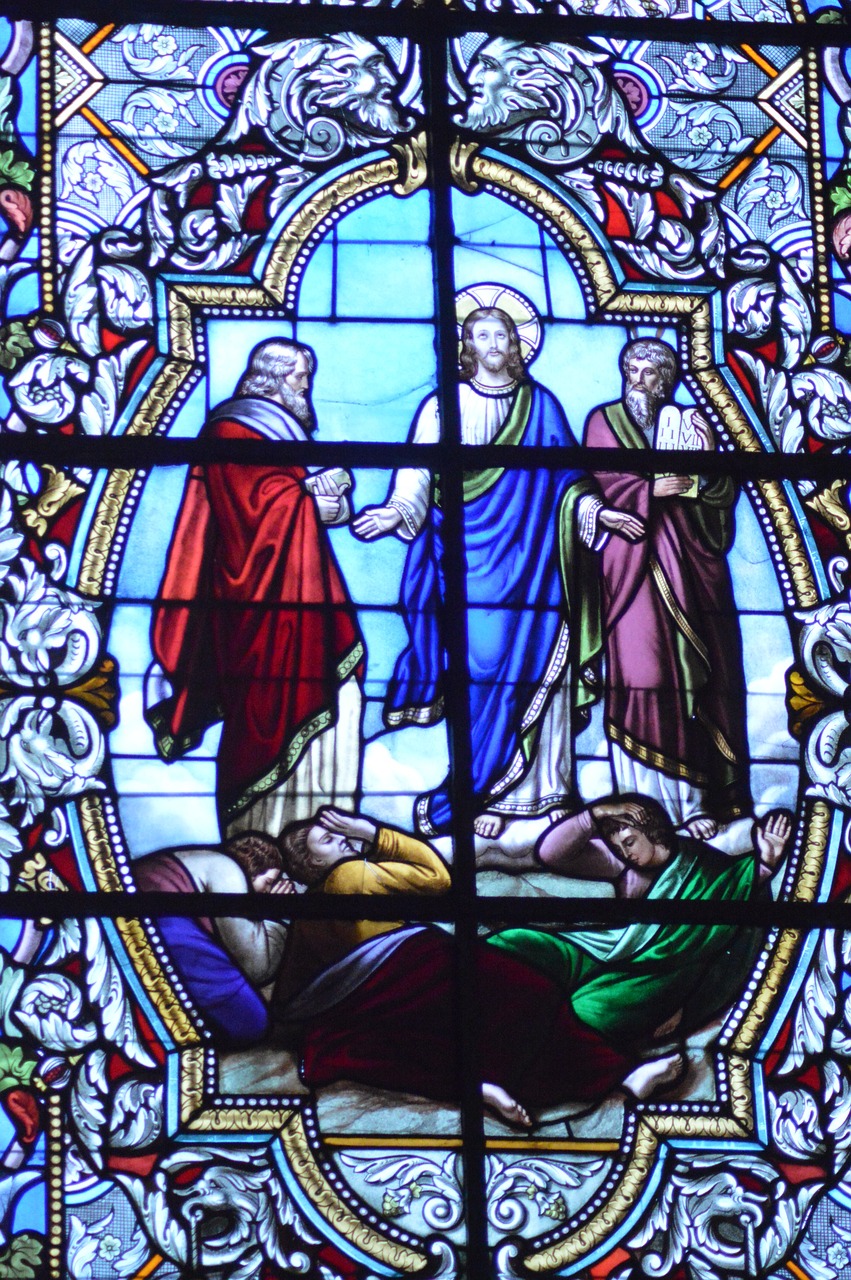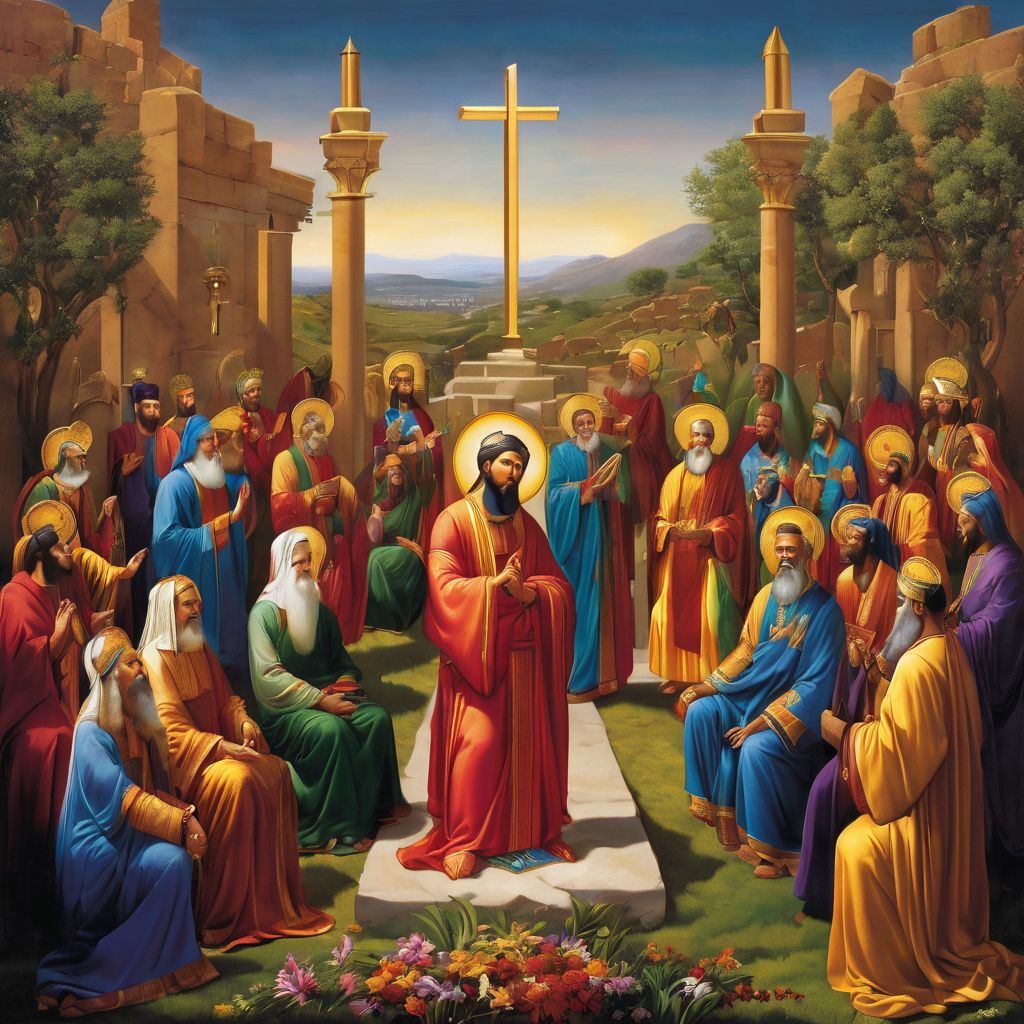Overview of Numbers Chapter 4 and Its Messianic Significance
A key example of messianic foreshadowing in Numbers chapter 4 is the account of the red heifer ritual outlined in Numbers 19. This ritual involved the sacrifice of a perfect red heifer outside the camp, burning it along with cedar wood, hyssop, and scarlet yarn, and using the ashes to purify those who had come into contact with a dead body. This ritual prefigures the ultimate purification and atonement brought about by Jesus Christ through His sacrificial death on the cross, providing cleansing and redemption for all who believe. Another significant instance is the bronze snake incident in Numbers 21, where the Israelites, suffering from a plague of venomous snakes, were instructed to look upon a bronze serpent placed on a pole to be healed. This serves as a prophetic symbol of Jesus’ crucifixion and the salvation and healing that He would bring to humanity through His sacrifice. These examples illuminate the messianic significance of Numbers chapter 4, offering profound insights into the redemptive work of Jesus Christ.
The Book of Numbers, authored by Moses, offers historical and spiritual accounts of the Israelites’ journey in the wilderness, emphasizing the themes of obedience, rebellion, repentance, and blessing. This historical context provides a rich backdrop for understanding the significance of Numbers chapter 4 and its messianic implications. The narratives within this chapter not only serve as a testament to the experiences of the Israelites but also present timeless lessons for believers of all generations. The emphasis on spiritual warfare and the preparation of believers to enter the Promised Land underscores the universal and timeless relevance of the Book of Numbers, setting the stage for exploring the profound messianic connections within its passages. Therefore, the authorship and context of Numbers chapter 4 play a pivotal role in providing the foundation for understanding the spiritual and prophetic significance of its narratives.
Authorship and Context of Numbers Chapter 4
Moses, the author of the Book of Numbers, offers a historical and spiritual account of the Israelites’ journey in the wilderness, providing profound insights into the challenges, triumphs, and spiritual lessons of the first and second generations of Israel. Through the narratives of obedience, rebellion, repentance, and blessing, the book serves as a guide for believers, illustrating the consequences of faithfulness and unfaithfulness in their journey with God. This context sets the stage for understanding the profound relevance of Numbers chapter 4 in the broader narrative of the Israelites’ spiritual and physical journey. The purpose of the book to prepare believers for spiritual warfare and their journey to the Promised Land underscores its universal and timeless significance, laying the groundwork for exploring the messianic, prophetic, and symbolic connections within Numbers chapter 4.
The Book of Numbers, written by Moses, not only chronicles the experiences of the Israelites in the wilderness but also contains timeless lessons in obedience and faithfulness, preparing believers for spiritual warfare and their journey to the Promised Land. In Numbers chapter 4, we find significant messianic foreshadowing, shedding light on the concept of the promised Messiah and prefiguring Christ’s sacrifice in the narratives of the red heifer and the bronze snake. For instance, the story of the red heifer, used in the purification process, symbolizes the cleansing and atonement that would be fulfilled through Christ’s sacrifice, pointing to its messianic significance.
Moreover, the bronze snake, which was lifted up by Moses in the wilderness to heal those who had been bitten by venomous snakes, serves as a prophetic symbol of Jesus’ crucifixion. Just as those who looked at the bronze snake were healed, believers today are spiritually healed by looking to Jesus on the cross. These messianic foreshadowings in Numbers chapter 4 not only demonstrate God’s redemptive plan throughout history but also provide profound insights into the symbolic connections to Jesus and the gospel, enriching our understanding of the Old Testament’s relation to the New Testament.
#MessianicConnections #PropheticRevelations #NumbersChapter4 #BiblicalProphecy #OldTestamentInsights
#DivineForetelling #MessianicProphecies #BiblicalAnalysis #PropheticVisions #ScripturalInterpretation
#Numbers4 #BiblicalExploration #MessianicForecast #PropheticInterpretation #BiblicalContext
#DivineForeknowledge #MessianicForeshadowing #PropheticMeanings #NumbersBook #ScripturalConnections
Messianic Foreshadowing
Numbers chapter 4 contains significant messianic foreshadowing, exemplified by the concept of the promised Messiah and the prefiguration of Christ’s sacrifice in the story of the red heifer and the bronze snake. This narrative lays the foundation for understanding the connections to Jesus and the gospel and offers profound insights into the redemptive work of God throughout history. The foreshadowing within the chapter alludes to the future coming of the Messiah, providing glimpses of the redemptive plan that would ultimately find its fulfillment in the person and mission of Jesus Christ.
One of the significant instances of messianic foreshadowing in Numbers chapter 4 is the story of the red heifer. This ritual, involving the sacrifice of a perfect red heifer and the use of its ashes for purification, prefigures the ultimate purification and atonement brought about by Jesus Christ through His sacrificial death on the cross, providing cleansing and redemption for all who believe. The red heifer ritual serves as a profound messianic foreshadowing, pointing to the cleansing and atonement that would be fulfilled through Christ’s sacrifice, emphasizing the continuity of God’s redemptive plan throughout history. This narrative lays the groundwork for understanding the spiritual significance and connections to Jesus and the gospel, enriching the understanding of the Old Testament’s relation to the New Testament.
Furthermore, the account of the bronze snake in Numbers 21 serves as a powerful messianic foreshadowing, symbolizing Jesus’ crucifixion and the salvation and healing that He would bring to humanity through His sacrifice. Just as those who looked at the bronze snake were healed, believers today are spiritually healed by looking to Jesus on the cross. This symbol of healing and salvation prefigures the redemptive work of Jesus Christ and underscores the profound spiritual significance embedded within Numbers chapter 4, pointing to Jesus as the ultimate source of healing and eternal life. These examples of messianic foreshadowing provide essential insights into the spiritual connections and foreshadowings of Jesus within the Old Testament narrative, emphasizing the continuity of God’s plan throughout history.
Prophetic Significance
The chapter holds prophetic significance through Balaam’s prophecy of Christ, offering insights into the future arrival and impact of Jesus as the fulfillment of Old Testament prophecies. The experiences of the Israelites in the wilderness are prophetically linked to Jesus, serving as foreshadowings and preparations for the arrival of the gospel message. These prophetic connections emphasize the divine plan of salvation that was set in motion from ancient times, providing glimpses of the promised Messiah and prefiguring the significant impact of Jesus on humanity.
Balaam’s prophecy of Christ, a non-Israelite prophet divinely inspired to utter prophecies concerning the future Messiah, serves as a remarkable foreshadowing of the coming of Jesus, highlighting the divine plan of salvation that was set in motion from ancient times. This prophecy offers profound insights into the future arrival and impact of Jesus as the fulfillment of Old Testament prophecies, providing glimpses of the promised Messiah and prefiguring the significant impact of Jesus on humanity. The experiences of the Israelites in the wilderness are prophetically linked to Jesus, serving as foreshadowings and preparations for the arrival of the gospel message, emphasizing the divine plan of salvation that was set in motion from ancient times. These prophetic connections underscore the profound continuity of God’s redemptive plan and His ongoing presence throughout history.
Symbolic Connections to Jesus and the Gospel
Numbers chapter 4 presents symbolic connections to Jesus, notably through the Pillar of Cloud and Fire, which signifies God’s presence and serves as a representation of Christ. The symbolic elements within the chapter provide deeper insights into the spiritual significance and connections to the life and teachings of Jesus, enriching the understanding of the gospel message. These symbolic connections not only reveal profound insights into the spiritual significance of Numbers chapter 4 but also illustrate the intricate tapestry of foreshadowings and representations that ultimately find their fulfillment in the person and work of Jesus Christ.
The symbolic connections to Jesus and the gospel, notably through the Pillar of Cloud and Fire, offer profound insights into the spiritual significance and connections to the life and teachings of Jesus, enriching the understanding of the gospel message. The Pillar of Cloud and Fire, often associated with the presence and guidance of God, holds symbolic representations of Christ’s role in the lives of believers. Just as the pillar guided the Israelites through the wilderness, Christ, as the “Light of the World” (John 8:12), illuminates the path of those who follow Him. The Pillar’s dual nature as both cloud and fire mirrors the multifaceted nature of Christ, who brings comfort and protection as well as refining and purifying fire to His followers. This symbolic imagery emphasizes the transformative and protective role of Jesus in the lives of His people, enhancing the understanding of His presence and guidance in the gospel message.
Moreover, the story of the red heifer and the bronze snake in Numbers chapter 4 holds profound symbolic connections to Jesus and the gospel. The red heifer’s ashes used in the purification ritual prefigure the cleansing from sin, which finds its ultimate fulfillment in the sacrificial death of Jesus on the cross, emphasizing the spiritual purification and sanctification brought about by His sacrifice. Additionally, the bronze snake incident serves as a powerful symbol of healing and salvation, directly linked to Jesus’ redemptive mission. Jesus referenced this very event when He spoke of His impending crucifixion, stating, “Just as Moses lifted up the snake in the wilderness, so the Son of Man must be lifted up, that everyone who believes may have eternal life in him” (John 3:14-15 NIV). This symbolic connection between the bronze snake and the crucifixion of Jesus underscores the profound spiritual significance embedded within Numbers chapter 4, pointing to Jesus as the ultimate source of healing and eternal life. These symbolic connections not only enrich the narrative of the Old Testament but also demonstrate the intricate tapestry of foreshadowings and representations that ultimately find their fulfillment in the person and work of Jesus Christ.
The Law of Moses and Its Relation to the Gospel
The law of Moses in Numbers chapter 4 is part of the preparatory gospel, containing elements such as faith in Jesus Christ, repentance, and baptism, along with the law of carnal commandments. This law encompassed not only the preparatory gospel but also the law of carnal commandments, which consisted of ordinances and performances designed to guide the children of Israel in understanding and adhering to the fundamental principles of the gospel. The law of Moses in Numbers chapter 4 not only provided a framework for the Old Testament covenant but also paved the way for the manifestation of the gospel in the New Testament era, demonstrating the continuity of God’s redemptive plan and the gradual unfolding of His divine purpose for humanity.
The law of Moses in Numbers chapter 4 is intertwined with the gospel message, providing crucial insights into the spiritual journey of believers and the redemptive work of Jesus Christ. The law of carnal commandments, with its focus on rituals and practices, was designed to instill discipline and self-control, preparing the people for a deeper comprehension of the spiritual truths that would later be revealed in Jesus Christ. These elements of the law of Moses laid the groundwork for the future fulfillment of the gospel through Christ, serving as a stepping stone for the Israelites to grasp the significance of the gospel message. Therefore, understanding the law of Moses in relation to the gospel illuminates the intricate connection between the Old Testament teachings and the fulfillment of those teachings in the life, death, and resurrection of Jesus Christ, bringing to fruition the spiritual principles laid out in Numbers chapter 4.
Key Verses and Their Significance
Key verses in Numbers chapter 4, including Numbers 6:24-26, 12:6-8, and 14:30-34, hold significant importance in understanding the messianic, prophetic, and symbolic aspects related to Jesus and the gospel. These verses provide essential insights into the spiritual connections and foreshadowings of Jesus within the Old Testament narrative, emphasizing the continuity of God’s plan throughout history. They offer glimpses of the promised Messiah and prefigure Christ’s sacrifice, providing profound insights into the redemptive work of God throughout history.
One of these key verses is Numbers 6:24-26, which presents the Priestly Benediction. This blessing, bestowed by God upon the Israelites through the priests, not only signifies God’s favor and protection but also foreshadows the ultimate blessing and peace that would come through Jesus Christ, the true High Priest [1]. Another key verse, Numbers 12:6-8, recounts how God differentiates Moses from other prophets, stating, “Hear now My words: If there is a prophet among you, I, the Lord, make Myself known to him in a vision; I speak to him in a dream. Not so with My servant Moses; he is faithful in all My house. I speak with him face to face, Even plainly, and not in dark sayings; And he sees the form of the Lord.” This distinction anticipates the unique relationship that Jesus, as the ultimate Prophet, would have with God the Father, speaking of Him plainly and intimately, and being faithful in all of God’s house, signifying His role as the mediator of a new covenant [1].
Lastly, Numbers 14:30-34 depicts the consequences of the Israelites’ disobedience and disbelief, leading to their wandering in the wilderness for forty years. This narrative serves as a poignant reminder of the perils of unbelief and rebellion, pointing to the need for faithfulness and obedience. Moreover, it serves as a foreshadowing of the redemptive work of Christ, who brings deliverance and victory from the wilderness of sin and unbelief, leading believers into the promised spiritual inheritance. These key verses in Numbers chapter 4 not only provide essential insights into the messianic, prophetic, and symbolic aspects related to Jesus and the gospel but also offer timeless teachings and admonitions for believers, emphasizing the redemptive continuity of God’s plan throughout history.
Practical Applications for Believers
Understanding Numbers chapter 4 in relation to Jesus and the gospel offers practical applications for believers, demonstrating the consequences of sin and unbelief, as well as providing examples for believers to observe and avoid. The chapter serves as a guide for believers, showcasing God’s restoration after repentance and the importance of returning to Him, providing timeless lessons for spiritual growth and obedience. Therefore, the practical applications derived from the narratives within Numbers chapter 4 serve as valuable lessons for believers, guiding them in their spiritual journey and encouraging steadfast faithfulness and obedience.
One of the key lessons from this chapter is the demonstration of the consequences of sin and unbelief. Throughout the narrative, the Israelites’ disobedience and lack of faith led to severe consequences, emphasizing the importance of obedience and trust in God. This serves as a poignant reminder to believers about the detrimental effects of straying from God’s will and the significance of maintaining a steadfast faith in Him. Moreover, Numbers chapter 4 provides clear examples for believers to observe and avoid. By examining the Israelites’ journey and their responses to God’s commands, believers can discern patterns of behavior and attitudes that are contrary to God’s desires. Through these cautionary examples, believers are equipped with the wisdom to make choices aligned with God’s will, fostering spiritual growth and maturity. Furthermore, the chapter in Numbers serves as a guide for believers, showcasing God’s restoration after repentance and the importance of returning to Him. The narrative illustrates God’s faithfulness in offering restoration and forgiveness to those who genuinely repent and turn back to Him. This timeless lesson provides believers with the assurance that no matter how far they may have strayed, genuine repentance and a return to God will always lead to His gracious restoration. This offers believers hope and encouragement, reinforcing the significance of seeking reconciliation with God and the transformative power of His forgiveness in their lives.
The Transformative Power of Faith and Encounters with Jesus
The transformative power of faith and encounters with Jesus, as demonstrated in the Enduring Word Bible Commentary on John chapter 4, highlights the impact of these experiences on individuals and their communities. The encounters with Jesus serve as powerful examples of faith and belief, illustrating the transformative and life-changing nature of encountering the teachings and person of Jesus. Therefore, the transformative power of faith and encounters with Jesus extends beyond the New Testament and is intricately connected to the Old Testament narratives, including Numbers chapter 4. These encounters serve as a testament to the unchanging character of God and the continuous narrative of His redemptive plan throughout history, culminating in the life, death, and resurrection of Jesus Christ.
The transformative power of faith and encounters with Jesus, as demonstrated in the Enduring Word Bible Commentary on John chapter 4, highlights the impact of these experiences on individuals and their communities. The Samaritan woman and the Jewish nobleman both encountered Jesus and experienced miraculous events, leading to transformative encounters and inspiring faith and belief in those who experienced these events. These encounters serve as a testament to the unchanging character of God and the continuous narrative of His redemptive plan throughout history, culminating in the life, death, and resurrection of Jesus Christ.
Moreover, the Samaritan woman’s encounter with Jesus illustrates the transformative power of faith, as she shared her story with others, leading many to believe. Her encounter serves as a powerful example of the impact of faith and belief, highlighting the transformative and life-changing nature of encountering the teachings and person of Jesus. Similarly, the nobleman’s faith was strengthened through his personal experience, as he believed Jesus’ word and experienced a miracle from a distance, leading him and his household to faith. The chapter highlights the transformative power of faith and encounters with Jesus, as the nobleman’s son was found healed, prompting his entire household to believe in Jesus and His power. These encounters serve as powerful examples of faith and belief, illustrating the transformative and life-changing nature of encountering the teachings and person of Jesus, reinforcing the enduring and timeless impact of faith and belief in the gospel message.
Conclusion
Recap the significant messianic, prophetic, and symbolic connections to Jesus and the gospel found within Numbers chapter 4, emphasizing the chapter’s profound relevance and continuous narrative of God’s plan throughout history. Encourage further exploration and study of the connections between the Old Testament and the life and teachings of Jesus, fostering a deeper understanding of the spiritual continuity present within the biblical texts. Therefore, as believers engage in this exploration, they are invited into a deeper understanding of the spiritual tapestry



